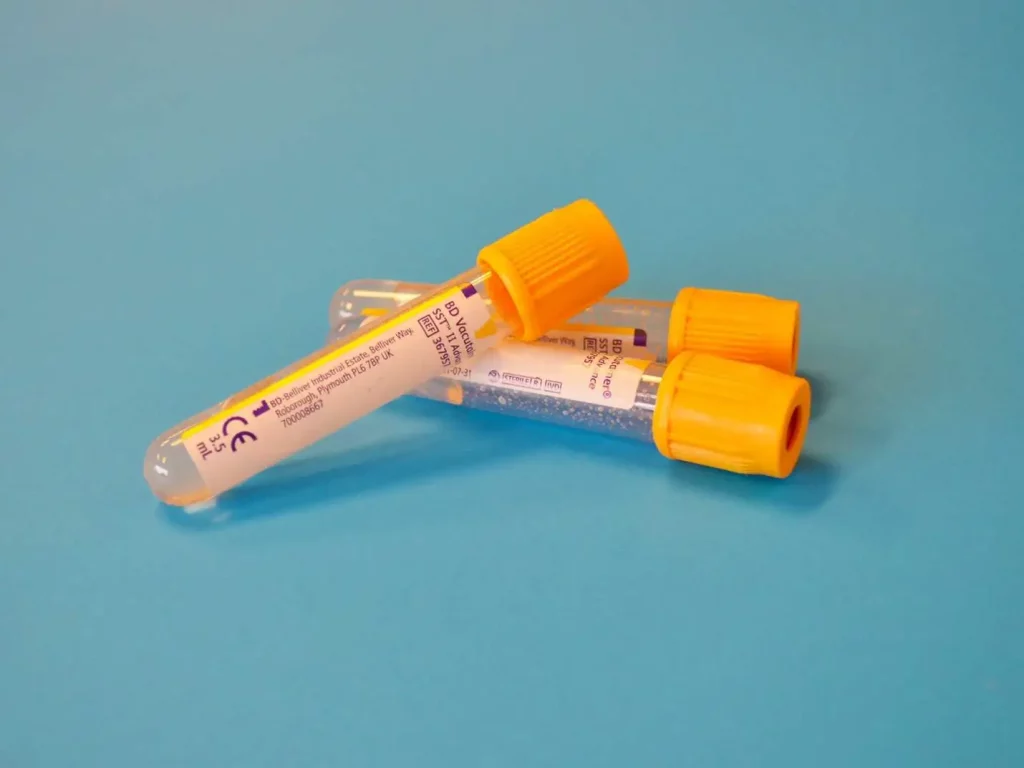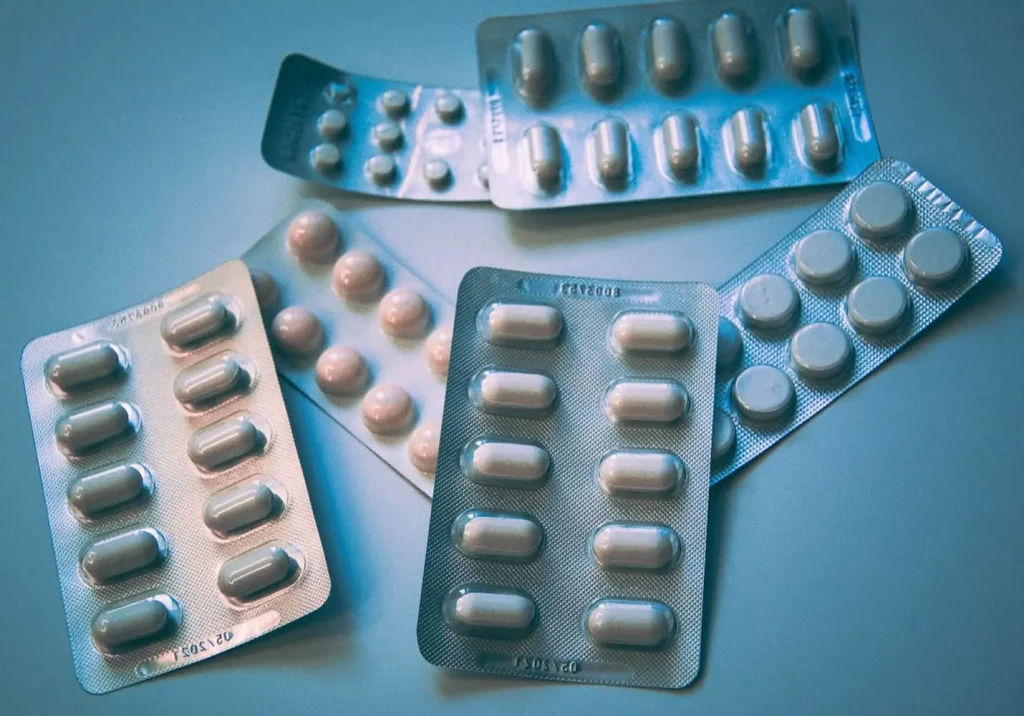What is Percocet?
Percocet is a prescription pain medication containing two active ingredients: the opioid oxycodone and the main ingredient in Tylenol known as acetaminophen, the latter being a non-opioid analgesic.
Its potent ingredients increase its effectiveness in managing moderate to severe pain over a short period. It is, therefore, dispensed to injury patients, after surgical procedures, and in chronic pain situations.
Percocet is most prevalent in a generic yellow oval shape, but some tablets can be branded white, blue, and round, with the latter often prescribed in lower doses.
Percocet dosages
Due to its potency, it is crucial that patients only take their prescribed dosages by their healthcare providers. There are two Percocet formulations: immediate-release (IR) versions and extended-release formulations (ER).
Immediate release formulations
IR Percocet is designed for a quick onset of action, rapidly releasing the medication into the bloodstream for fast pain relief. Its effects are short-lived, requiring patients to take them after every 4-6 hours for consistent pain control. This formulation is often prescribed for acute pain situations.
The dosages for immediate-release formulations are:
- Percocet 2.5 mg/325 mg – the lowest dosage prescribed.
- Percocet 5mg/325 mg – the acetaminophen in this dosage equals that of 2.5mg/325 mg.
Extended-release formulations
ER Percocet formulations gradually release the medication into the bloodstream over an extended period, leading to long-lasting pain relief. Due to its longer duration of action, patients take it less frequently than immediate-release formulations. It is often prescribed under chronic pain situations where around-the-clock pain relief is needed.
The dosages prescribed for extended-release versions are:
- Percocet 7.5mg/325 mg – this is one of the strongest dosages with higher amounts of acetaminophen to extend pain relief duration while minimizing opioid use.
- Percocet 10mg/325 mg – this is the highest dosage prescribed.
Regardless of your pain situation, it is not recommended to self-adjust your Percocet dosage or use the medication without proper medical guidance.
How does Percocet work
Understanding how Percocet works in your body, its timelines, and factors is essential when using this medication. Due to its combination of components, we will explore the working mechanisms of both components in the body.
1. The Opioid Analgesic
Oxycodone, the opioid component of Percocet, binds to the opioid receptors in the brain and the spinal cord, which regulate the body’s pain management. The receptors alter the perception of pain by inhibiting the transmission of pain signals along the neural pathways.
2. The Non-opioid Analgesic
Acetaminophen works as an enzyme inhibitor. The cyclooxygenase (COX) enzyme produces prostaglandin, the chemical involved in the inflammatory response and pain signaling. Once acetaminophen inhibits the COX enzyme, prostaglandin production is reduced, thereby alleviating pain sensation and reducing fever.
The above analgesics produce a synergistic effect to modulate pain perception and reduce inflammation.
How Percocet is metabolized in the body: how does Percocet stay in your system?
Percocet requires extensive metabolism due to its potent components. Understanding how it’s broken down in the body will help elaborate on its elimination.
Both oxycodone and acetaminophen are metabolized in the liver through several enzymatic processes.
Oxycodone is metabolized by the CYP3A4 enzyme, which results in active and inactive metabolites. Acetaminophen metabolism results in the production of water-soluble metabolites, which are excreted through the kidneys.
Generally, it would take several half-lives for the drug to be eliminated in your system. The half-life of a drug is the time your body would take to eliminate half of the drug from your system.
For instance, the opioid component of Percocet has a half-life of about 3.2 hours, while acetaminophen’s half-life is 2 to 3 hours.
Altogether, your body would take around five half-lives to clear out Percocet, amounting to about 16 hours since last use. Nonetheless, the elimination process leaves traces of the metabolites, explaining how Percocet stays in your system. Several factors affect the duration these metabolites linger in your system.
Factors influencing how long Percocet stays in your system
- Metabolism rate – individuals with a faster metabolism will process and eliminate Percocet more quickly.
- Age – metabolism rate reduces with age, leading to a longer detection time.
- Liver function – since Percocet metabolism occurs in the liver, an impaired liver function will slow down the process, extending the drug’s duration in the body.
- Body mass – Percocet is lipophilic, meaning it has a high affinity for fat tissues. Individuals with a higher body fat content can store Percocet metabolites in their fat tissues, prolonging their duration of action.
- Hydration – proper hydration is important for kidney function and drug elimination. Dehydration can result in the slow excretion of the drug.
- Dosage and frequency of use – higher doses and regularity of use extend the time it takes Percocet to leave the system.
- Overall health – general body health and kidney function can affect drug elimination in the body.
Drug testing for Percocet

Percocet metabolites remain detectable in various bodily substances beyond the 16 hours it would take for its effects to wear off and clear out. This is where drug tests come in.
However, the drug test doesn’t test for Percocet medication but rather for oxycodone/opioid metabolites. Tylenol (acetaminophen) is hardly tested for as it’s a non-habit-forming medication.
Percocet detection window
In urine
Urine testing is a standard and affordable method due to its easy procedure. The detection window for Percocet in urine is highly dependent on liver and kidney function as well as overall consumption of the drug.
However, some sources say it is detectable for up to 2 days since last use, with the window starting within two hours of the first immediate-release Percocet dosage.
In blood
Oxycodone is detectable in a blood sample for up to 24 hours after use. This is a relatively low detection window that may require subsequent screening had the user consumed Percocet more than a day ago.
In saliva
The detection window in saliva is between 1 to 2 days after the last dose of Percocet.
In hair
The hair strand test has the longest detection window, detecting drug use over the past 90 days. Due to its long-term reliability and costly nature, hair testing is often reserved for detecting chronic and long-term illicit drug use.
Percocet Abuse
The misuse and abuse of Percocet has been on the rise, posing a serious health risk. Due to its potent opioid component, misuse of Percocet often leads to drug tolerance, which develops into addiction over prolonged use.
A comprehensive review of how oxycodone is addictive is available here.
Below is a comprehensive discussion of the causes, signs and symptoms of abuse.
Causes/Risk factors of Percocet abuse
- Pain management issues – patients may misuse Percocet as a means of self-medicating chronic pain or due to inadequate pain relief from their ongoing prescription. Lack of patient monitoring by healthcare providers can also encourage its misuse and abuse.
- Psychological factors – the oxycodone in Percocet has euphoric effects that may cause one to develop a physical and psychological dependence on the drug. It can also be misused during stressful, traumatic, and emotionally abusive situations as a coping mechanism.
- Seeking pleasure – due to its availability and ready market, Percocet is often misused as a recreational drug for individuals seeking an opioid high, relaxation, or escape from reality.
- Peer influence – social circles may also glamorize drug use, which contributes to Percocet abuse.
- History of substance use disorder (SUD) – users with a history of SUD and relapse are at a higher risk of abusing Percocet once it’s prescribed.
- Genetics – genetic factors can influence an individual’s susceptibility to substance abuse, especially opioids like Percocet.
Signs and symptoms of Percocet abuse
Behavioural and psychological signs
- Sudden mood swings.
- Isolation.
- Euphoria or unnatural ‘highs’, followed by an intense ‘crash’.
- Anxiety and paranoia.
- Doctor shopping to acquire multiple prescriptions.
- Neglecting responsibilities to chase a ‘high’.
Physical signs
- Increased tolerance – needing higher doses to achieve the same effect.
- Experiencing withdrawal symptoms when the drug wears off. These symptoms may range from mild muscle and joint aches, runny nose, and teary eyes to intense chills, sweating, and cravings.
- Drowsiness.
- Constricted pupils.
- Gastrointestinal stress manifesting through nausea and vomiting.
Effects of Percocet abuse
- Liver damage – when acetaminophen is taken in excessive dosages, it overwhelms the liver’s ability to metabolize the drug, leading to the accumulation of toxic byproducts that can damage liver cells.
- Respiratory problems – excessive intake of opioids tends to suppress the respiratory system by binding to special opioid receptors that inhibit the brain centre regulating breathing.
- Addiction – prolonged abuse of Percocet can lead to addiction.
- Increased risk of overdose – high dose of Percocet in combination with other drugs can lead to an overdose, which can turn fatal.
- Social and legal issues – addictions tend to strain social relationships and lead to illegal activities as the addict strives to obtain funding for the drug.
Signs of a Percocet overdose
An overdose usually occurs when the drug consumption exceeds the body’s ability to metabolize it. In extreme situation, a Percocet overdose can be life threatening and, therefore, requires immediate medical attention.
Key indicators of an overdose include:
- Respiratory suppression; shallow breathing or shortness of breath (SOB).
- Loss of consciousness.
- Confusion.
- Low blood pressure and a weak pulse.
- Bluish tint on the lips and extremities.
- Cold and clammy skin.
- Pinpoint pupils.
In case of an opioid overdose, naloxone can be administered to reverse the effects if available. Otherwise, call for medical help.
Treatment and intervention
A Percocet addiction is as potent as any other opioid addiction, preventing one from quitting cold turkey.
Consistent medical supervision is, therefore, required to help manage withdrawal and support the patient all through the process.
Treatment plans applied during drug elimination and withdrawal management include:
Medical detox
A medically supervised detoxification program ensures the safety and comfort of the patient and proper management of the withdrawal symptoms. During this time, vital signs such as blood pressure, heart rate, and respiratory rate are closely monitored in case of an emergency.
Medication-Assisted Treatment (MAT)
Certain medications may be prescribed to help manage drug cravings and prevent a relapse. Symptom-specific medications can also be administered to address specific withdrawal symptoms.
Behavioral Therapy (BT)
Behavioral therapies such as counselling and support groups can provide addicts with coping strategies as they share peer experiences and emotional support to get clean. Through cognitive-behavioral therapy (CBT) they can effectively address the psychological aspects of addiction and withdrawal.
Holistic approaches
These are achieved through incorporating proper nutrition and physical activity in recovery to achieve the overall well-being of the individual. Exercises such as yoga, meditation, and mindfulness can help manage anxieties and improve relaxation.
If you or your loved one is struggling with Percocet abuse, reaching out to healthcare providers and addiction specialists is imperative for effective intervention and recovery.


